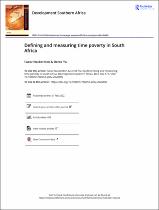| dc.contributor.author | Nackerdien, Faeez | |
| dc.contributor.author | Yu, Derek | |
| dc.date.accessioned | 2024-02-15T08:58:55Z | |
| dc.date.available | 2024-02-15T08:58:55Z | |
| dc.date.issued | 2023 | |
| dc.identifier.citation | Nackerdien, F. and Yu, D., 2023. Defining and measuring time poverty in South Africa. Development Southern Africa, 40(3), pp.560-579. | en_US |
| dc.identifier.issn | 0376835X | |
| dc.identifier.uri | http://dx.doi.org/10.1080/0376835X.2022.2028606 | |
| dc.identifier.uri | http://hdl.handle.net/10566/9309 | |
| dc.description.abstract | This study primarily adopted the absolute approach to examine time poverty in South Africa by analysing the 2000 and 2010 Time Use Survey data. The findings indicated that absolute time-poor individuals were predominantly young unmarried female Africans who had incomplete primary education, were inactive in the labour market and resided in bigger-sized households in KwaZulu-Natal and Gauteng. Examining the relationship between money-metric poverty and absolute time poverty, the results showed the proportion of people who were both income- and time-poor decreased whereas the percentage of individuals who were neither income- nor time-poor increased over time. Last, money-metric, multidimensional non-money-metric and absolute time poverty headcount rates all declined between 2000 and 2010, but the extent of decrease was greatest in the first rate. © 2022 Government Technical Advisory Centre (GTAC). | en_US |
| dc.language.iso | en | en_US |
| dc.publisher | Routledge | en_US |
| dc.subject | Systems of national accounts | en_US |
| dc.subject | Time poverty | en_US |
| dc.subject | Time use survey | en_US |
| dc.subject | South Africa | en_US |
| dc.subject | Poor individuals | en_US |
| dc.title | Defining and measuring time poverty in South Africa | en_US |
| dc.type | Article | en_US |

